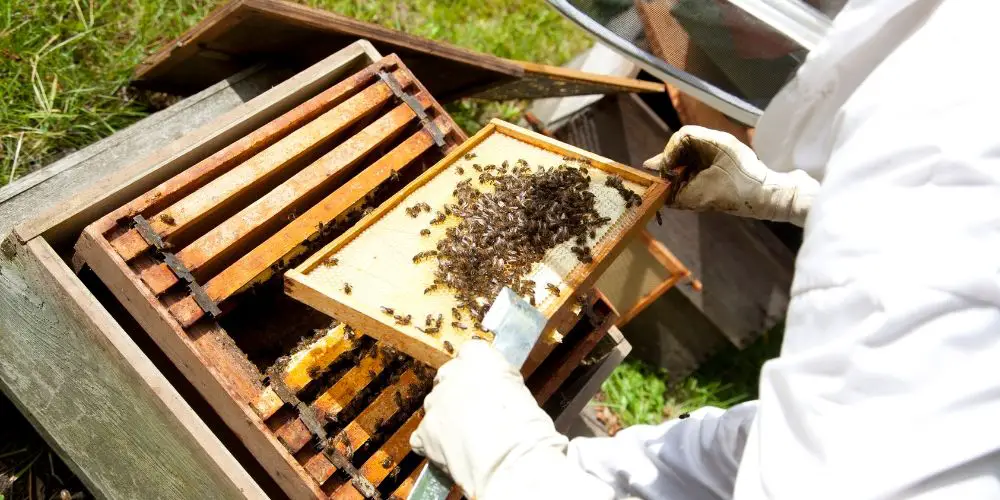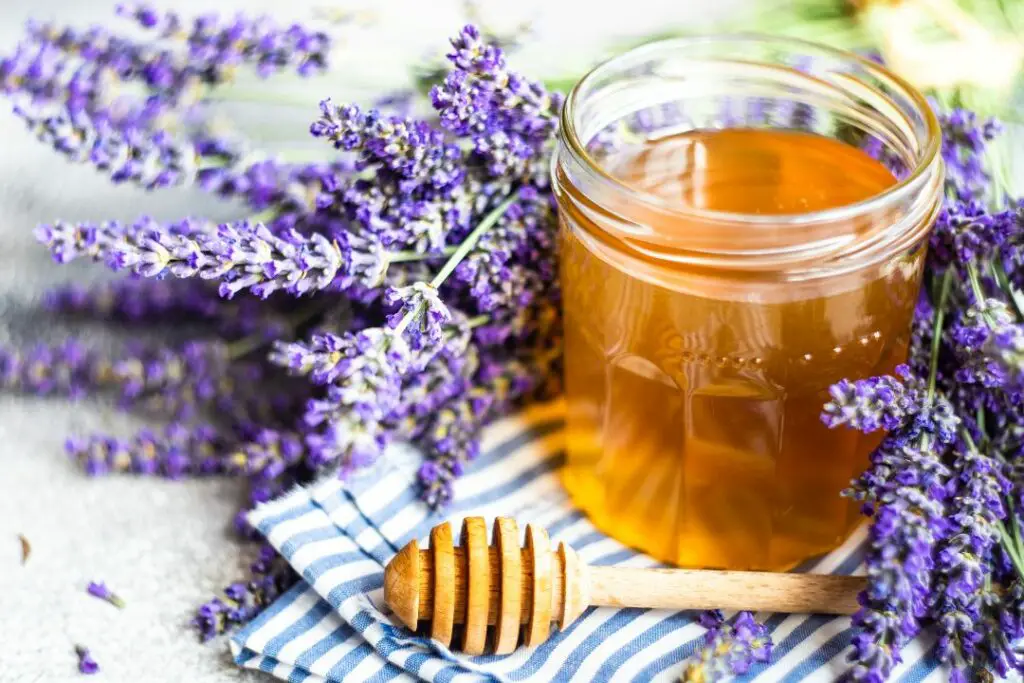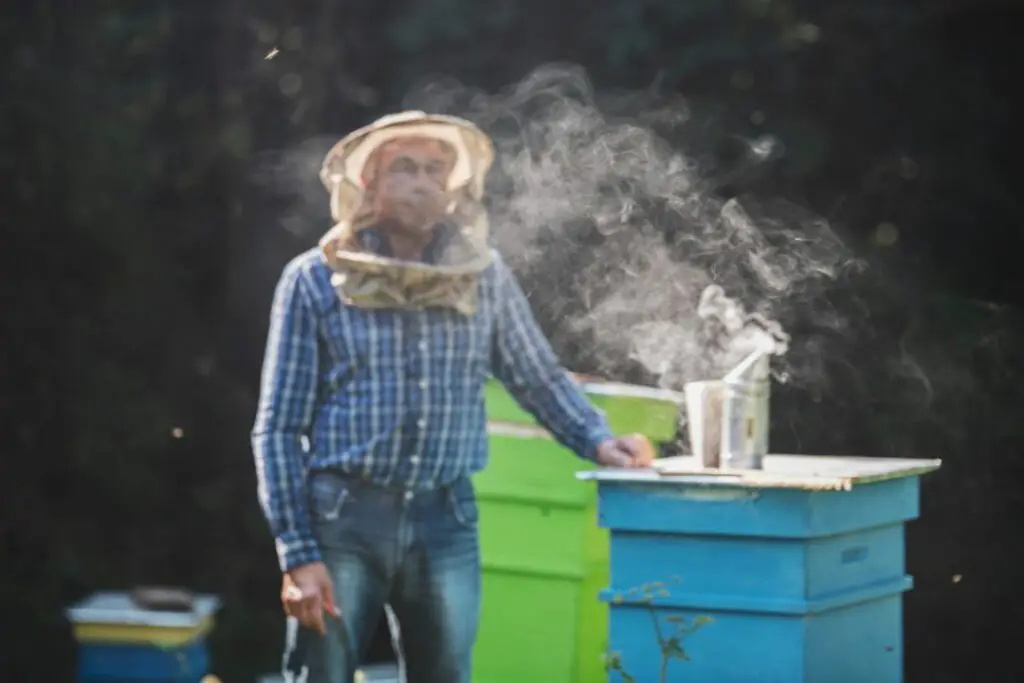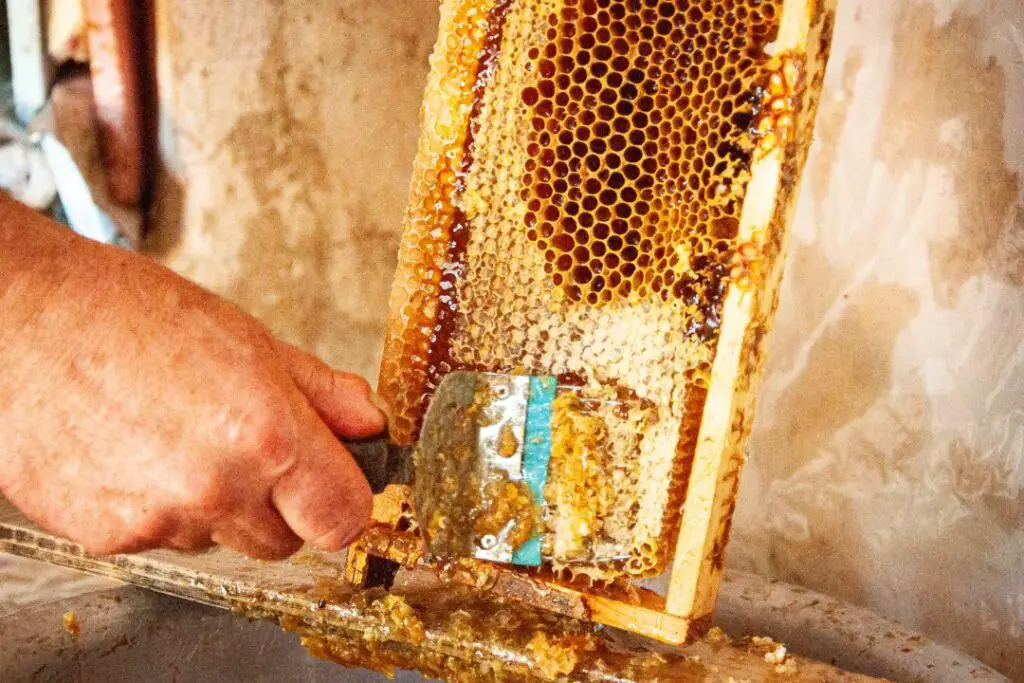Last updated on September 21st, 2023 at 11:59 am
If you’re a beekeeper, you probably know your bees are vulnerable to diseases and pests.
Part of keeping them healthy and productive is quickly identifying the most common bee illnesses and taking preventive measures to protect your hives and colonies.
Let’s take a look at the most frequent diseases affecting honeybees (apis mellifera) today and some handy tips on how these you can prevent or treat when necessary.
From recognizing the signs of external parasites such as disease-carrying mites to safely medicating infected hives we’ll provide an overview of key points every beekeeper should remember when caring for their colony.
American Foulbrood (AFB)
This is a bacterial infection caused by the spore-forming bacteria Paenibacillus larvae. It affects colonies of all sizes and will present a risk to otherwise healthy hives.
The signs of AFB are easily recognizable, with infected larvae appearing sunken and discoloured in the bottom of their cells. The disease can be highly contagious, fatal and spread rapidly without suitable control measures.
Affected larvae will normally expire in the pre-pupal or pupal stage before reaching maturity.
*Pro tip – Even though AFB isn’t highly contagious it can be spread by bees within the colony or by using infected bee-keeping equipment.
Prevention of American Foulbrood (AFB)
The best way to prevent AFB is to regularly inspect your hives and detect the presence of the bacteria at its early stages.
Look for perforated, dark or sunken cells, larvae will liquefy fairly quickly after death so liquid-filled brood cells are often a late signal.
This decomposition of larvae within the brood combs can lead to a sulphurous smell that isn’t present in healthy hives.
Sadly the only course of action for the infected frames is to be replaced or burned, and any equipment used in the removal should be cleaned and disinfected thoroughly.
Head over to our friends at Bee Aware for a closer look at this devastating bacteria, how to identify symptoms and the best ways to manage bees infected by American foulbrood disease.
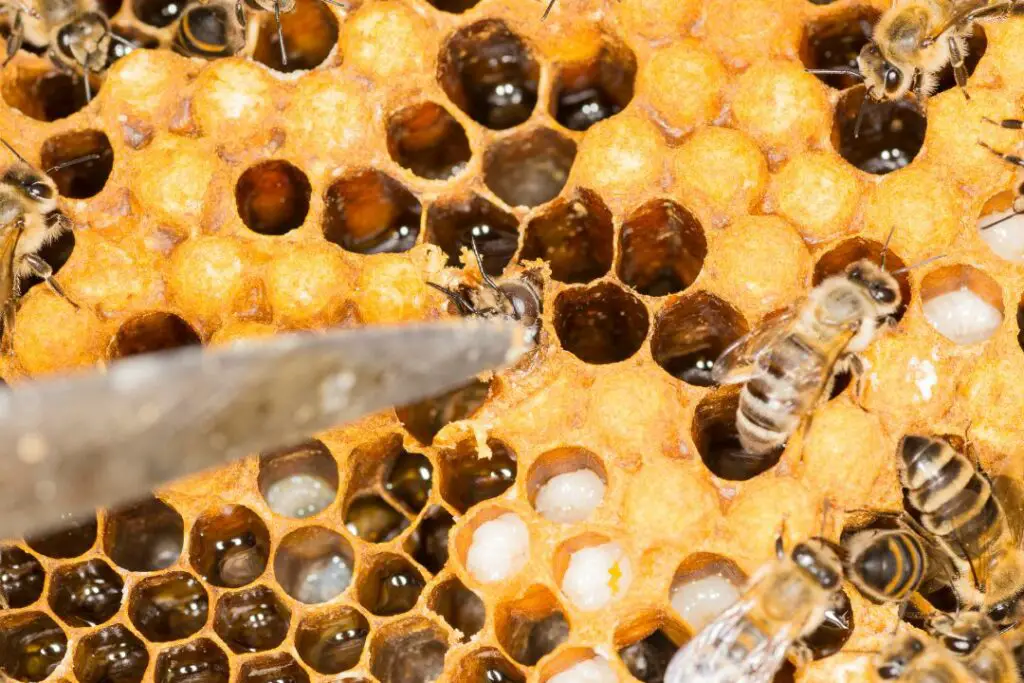
European Foulbrood (EFB)
European Foulbrood is another bacterial infection caused by the bacteria Melissococcus plutonius. It poses a risk to all the larvae in a colony and is spread by the consumption of food contaminated with the bacteria.
Once ingested the bacteria multiplies in the gut, begins to fight for nutritional sustenance and eventually kills the larvae due to starvation.
The signs resemble AFB, with clear indicators like:
- uneven or patchy brood
- larvae expired in uncapped cells
- a sour, ammonia-like smell
It’s important to note that European Foulbrood unlike American Foulbrood is related to stress within the colony caused by factors like lack of food, pest infestation or a hazardous climate around the hive.
Prevention of European Foulbrood (EFB)
Inspection and identification at an early stage are essential to keeping EFB under control. We recommend inspecting your hives at the bare minimum twice a year in Spring and Autumn but more regular checks are preferential.
Any diseased comb or brood should be removed as quickly as possible, replacing your brood frames every 2-4 years will help prevent the build-up of EFB.
Try to remove any causes of stress like lack of resources or adverse weather conditions with sugar syrup and hive relocation.
EFB has also been linked to severe changes in temperature so ensuring your hives aren’t in full sun or heavy wind is a great option.
*Pro tip -Implementing barrier controls like not sharing hive equipment is a great way to remove the chance of bacterial spores moving from hive to hive.
Varroa Mites
Varroa mites (varroa destructor) are external parasites that feed on the hemolymph (essentially our equivalent of blood) of bees.
Varroa mites predominantly feed on the larvae of the western honeybee but the adult female Varroa mite can and will feed on adult honeybees.
*Interesting fact – Did you know Australia is the only major honey-producing country with no reported cases of Varroa Mites?
They look oval in shape with a dark brown-red colouring and are roughly 1mm x 1.5mm in length and width.
Juvenile Varroa Mites are always smaller and tend to be lighter in colour in comparison to their adult counterparts.
Low levels of infestation in a hive will show little to no symptoms but as th number of mites increase you will start to see some of the following:
- Brood scattered across the hive
- An increase in workers not returning to the hive after foraging flights
- Impaired flight and crippled wings
- Loss of body weight
- Shorter lifespans
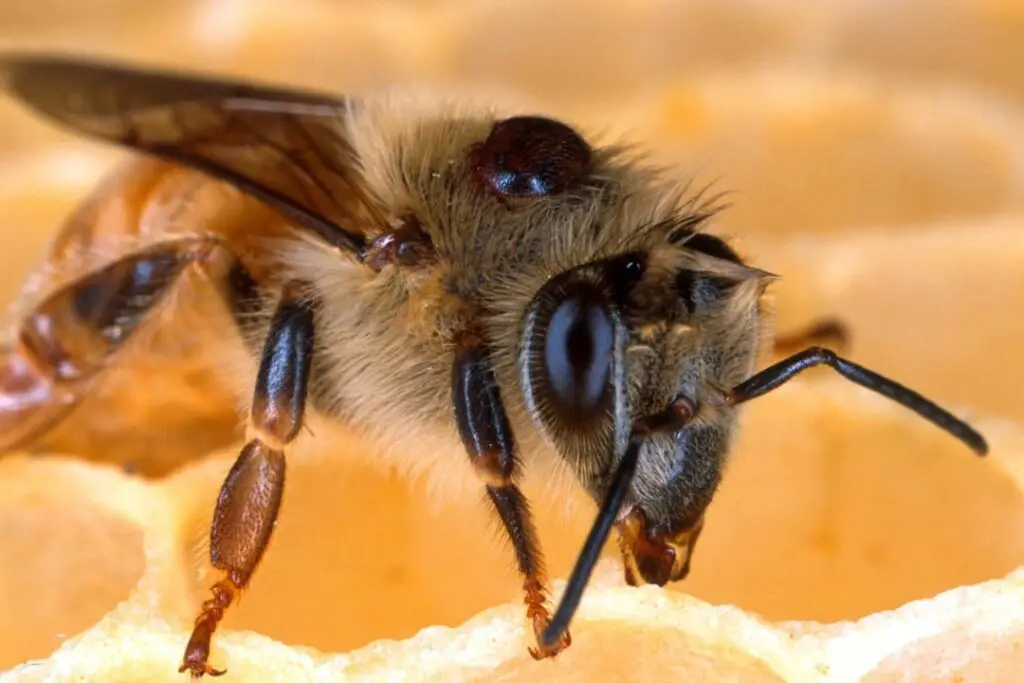
Prevention of Varroa Mites
Screened Bottom Boards – Placing sticky traps underneath your screened bottom boards is a perfect way to capture any mites that dislodge from their host while in the hive.
Sugar shake and roll – Dusting bees with powdered sugar, bees use this much like a mammal would use dust to remove parasites, rolling around and dislodging them using the small pieces of sugar.
Pro tip – Try to avoid powdered sugar that contains cornstarch as this is an unnecessary addition that may have detrimental effects on your bee colony’s health.
Natural remedies – Both Mint and Thyme in their essential oil forms are effective ways of treating your hives. Soak some strips of cloth in your oils and place them between your frames for at least three days to see results.
Some beekeepers have turned to formic acid to help tackle Varroa infestations in their bee brood. It’s the same natural acid ants produce so it’s not damaging to the environment and it’s been shown to be effective at treating Tracheal Mites which we’ll discuss later.
Nosema Disease
One of the most damaging diseases of bees, Nosema is a fungal infection caused by the organism Nosema ceranae and Nosema apis.
Nosema spores are ingested by bees on foraging trips. In as little as 30 minutes after ingestion, the spores will begin to germinate before bursting through cells that make up the bee’s stomach lining (rather unpleasant to say the least!).
Using the contents of each cell for food the parasites will begin to move to adjacent cells effectively spreading the disease around the bee’s body.
Nosema typically affects hives in lower temperatures when inhabitants are taking less flights with heavy losses normally occurring at the start of Spring and late Autumn.
The disease has a wide range of effects on bees with some of the most common being:
- The inability of nurse bees to produce Royal Jelly
- Eggs failing to produce mature larvae
- Nurse bees reject their duties and opt to forage or guard
- An increase in dysentery amongst the hive population
Prevention of Nosema Disease
The best way to prevent Nosema disease is by ensuring the hive has adequate ventilation and that the bees are well-fed.
The use of approved fungicides can also help control the spread of disease and beekeepers will often dose their sugar syrup feed with Fumagilin-B.
Damp conditions are conducive to the spread of Nosema so always make sure your hives get sunlight and suitable ventilation.
Acarine Disease
Acarine disease, also known as Acarapisosis, is a condition that affects the respiratory system of Western honeybees. It is caused by a microscopic mite called Acarapis woodi, which lives in the tracheae (breathing tubes) of adult honeybees.
These Tracheal Mites enter via spiracles or breathing holes in the bee’s abdomen. This obstructs the breathing tubes of the bees, leading to respiratory problems and a reduced lifespan.
The acarine disease was once a common problem for honeybees, but it has become less prevalent in recent years due to improved management practices and the use of medications to control the mites.
Prevention of Acarine Disease
Certain species of bees like the Buckfast have a natural resistance to this invading mite with others like the Newzealand honeybee being incredibly suscep[tible.
Menthol crystals are often employed as a natural remedy for Acarine Disease but if this doesn’t do the trick you’ll need to reach for something like Apigurad which is also effective in the treatment of other issues like Varroa.
Chalkbrood
Chalkbrood is a fungal disease that affects honeybee larvae. It’s caused by the fungus Ascosphaera apis, which infects the larvae’s digestive system.
*Interesting fact – The disease is called chalkbrood because infected larvae turn a chalky white colour as they die and dry out.
Chalkbrood spores can survive in hive debris and infected comb for many years, and the disease can be spread from colony to colony by contaminated equipment, bees, or robbing.
Stress factors such as low temperatures, humidity, poor nutrition, and overcrowding can also make the bees more susceptible to the disease.
Chalkbrood is not usually a serious threat to the overall health of the hive, as it typically affects only a small percentage of the brood. However, severe outbreaks can weaken the hive and reduce honey production.
Prevention of Chalkbrood
As with most of the issues on this list, beekeepers can help prevent and control chalkbrood by maintaining healthy hives, avoiding stress factors, and using proper hygiene and sanitation practices.
Here’s our 7-step guide to keeping your bees happy, healthy and chalkbrood-free:
- Maintain strong colonies: Ensure that the hives have enough bees, honey, pollen, and water.
- Proper ventilation: Proper ventilation helps to keep the hive dry, reducing the moisture level which is a risk factor for chalkbrood.
- Good nutrition: Adequate food supply, including pollen and nectar, enhances the health of the hive and improves the bees’ immunity to diseases.
- Replace old and contaminated combs: Old combs can harbour spores that can cause chalkbrood. Replace old combs to reduce your chances of an outbreak.
- Maintain hygiene: Regularly clean and sanitize equipment, tools, and hive components to reduce the risk of contamination.
- Reduce stress: Minimise stress factors like overcrowding, excessive heat, and transport to prevent your bees from becoming weakened.
- Genetic selection: Choose bees that are known to have resistance to chalkbrood through selective breeding like Buckfasts.
Hive beetles
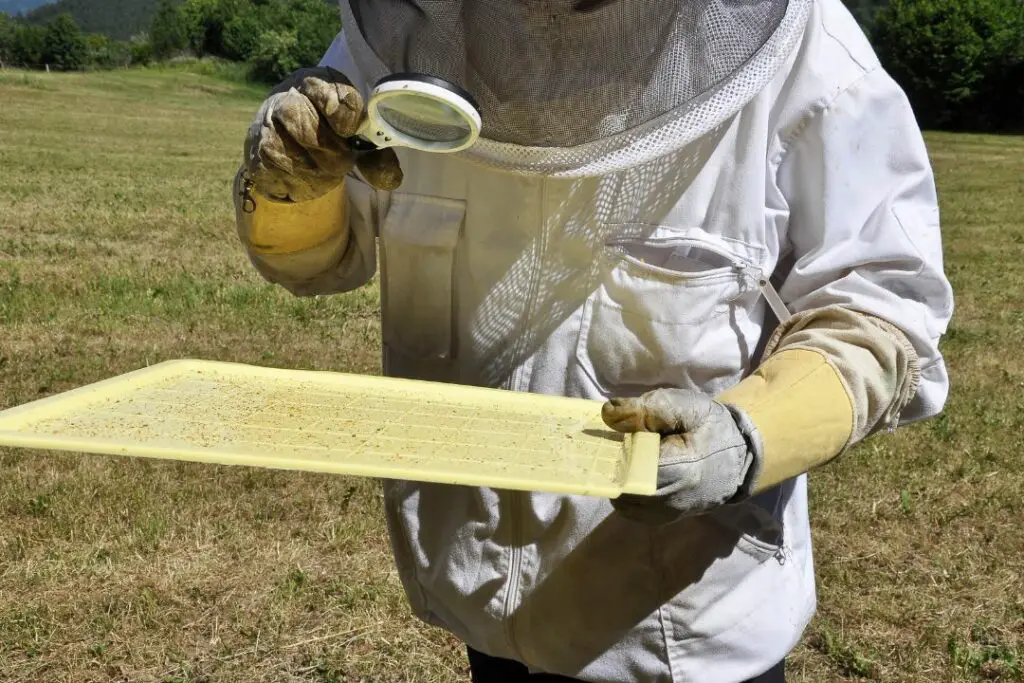
Hive beetles (aethina tumida) are small darkly coloured beetles that feed on the honey and pollen found in bee hives.
They’ve been found in frames from Australia, the Philippines and North America and pose a serious threat to hives of all sizes.
The signs of infestation include adult beetles and larvae in bee cells and dark spots on the wax combs.
The beetles can spread quickly throughout a colony and can cause serious health implications for the bee population.
As the beetles travel from comb to comb they defecate, quickly spoiling the carefully stored honey and causing the fermentation process.
Prevention of Hive Beetles:
Strong colonies of bees can protect themselves from pests like hive beetles. Make sure your hive has enough bees, a good queen, sufficient honey, and pollen stores to maintain the health of the hive.
Regularly remove debris and excess honey and pollen from the hive to eliminate food sources for the hive beetles.
Regular monitoring of the hive is essential to detect and control a hive beetle infestation early and hive beetle traps can be installed in the hive to capture adult beetles
If the infestation is severe, chemical control may be necessary. Always use chemicals carefully, following the label instructions and avoiding contaminating the hive.
Some natural predators like the small hive beetle-eating beetle (A. punctatus), which is native to Africa, can be introduced to the hive to control the population of hive beetles.
Conclusion:
Understanding the most common bee diseases and taking preventive measures can protect your hives from infection and keep your bees healthy and productive.
The best way to prevent these diseases is by regularly inspecting your hives, taking appropriate sanitary measures, and using approved treatments if necessary.
With some knowledge and careful management practices, you can help ensure your hive’s inhabitants stay healthy and productive for years.
FAQs:
What are the most common bee diseases?
The most common bee diseases include American Foulbrood, European Foulbrood, Nosema Disease, Hive Beetles, Wax Moth, and Varroa mites.
How can I prevent these diseases?
The best way to prevent these diseases is with good hive management. Integrated Pest Management (IPM) techniques such as chemical pesticides or trapping and removal of pests can also help reduce the risk of disease infestation.
What should I do if my hive is infected?
In most cases, the infected frames should be replaced or burned, and any equipment used in the hive should be thoroughly cleaned.
The use of approved antibiotics can also help to control the spread of the disease.
In some cases, professional beekeeping services or your local beekeeping association may need to be called upon for assistance in treating an infected hive.

